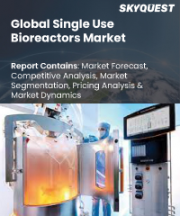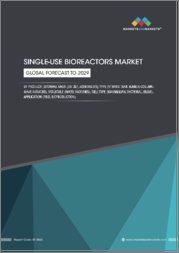
|
시장보고서
상품코드
1714190
미국의 일회용 바이오리액터 시장 : 제품 유형별, 모듈 유형별, 세포 유형별, 용도별, 최종사용자별, 지역별, 기회 및 예측(2018-2032년)United States Single-use Bioreactors Market Assessment, By Product, By Type of Module, By Cell Type, By Application, By End-user, By Region, Opportunities and Forecast, 2018-2032F |
||||||
미국의 일회용 바이오리액터 시장 규모는 2025-2032년 예측 기간 동안 17.98%의 CAGR로 2024년 12억 7,100만 달러에서 2032년 47억 7,104만 달러로 확대될 것으로 예측됩니다. 생물학적 제제 및 맞춤형 치료제에 대한 수요가 증가함에 따라 미국 시장에서 일회용 바이오리액터의 채택이 가속화되고 있습니다. 유연성, 교차 오염 위험 감소, 낮은 자본 투자로 인해 최신 바이오 생산에 이상적이라는 평가를 받고 있습니다. 자동화 및 연속 바이오 공정 기술의 발전으로 인해 일회용 바이오리액터는 확장성과 효율성을 향상시키는 데 있어 그 역할이 더욱 커지고 있습니다.
예를 들어, 2025년 1월 Danaher는 헬스케어 인공지능 기업 Innovaccer Inc.에 전략적 투자를 발표했습니다. 이 제휴는 Danaher의 진단 기술과 Innovaccer의 AI 기반 통합 환자 기록 플랫폼을 통합하여 환자 결과를 개선하고 정밀의료와 가치 기반 치료의 도입을 촉진하는 것을 목표로 하고 있습니다.
미국의 일회용 바이오리액터 시장에 대해 조사했으며, 시장 개요와 함께 제품 유형별, 모듈 유형별, 셀 유형별, 용도별, 최종사용자별, 지역별 동향, 시장 진출 기업 프로파일 등의 정보를 전해드립니다.
목차
제1장 프로젝트 범위와 정의
제2장 조사 방법
제3장 미국 관세의 영향
제4장 주요 요약
제5장 미국의 일회용 바이오리액터 시장 전망, 2018-2032년
- 시장 규모 분석과 예측
- 시장 점유율 분석과 예측
- 제품별
- 일회용 바이오리액터 시스템
- 일회용 미디어 백
- 일회용 여과 어셈블리 및 액세서리
- 모듈 유형별
- 교반 탱크 SUB
- 파동 야기 SUB
- 버블 컬럼 SUB
- 기타
- 세포 유형별
- 포유류 세포
- 세균 세포
- 효모 세포
- 기타
- 용도별
- 바이오 프로덕션
- 프로세스 개발
- 연구개발
- 최종사용자별
- 제약회사·바이오테크놀러지 기업
- 임상연구기관
- 학술연구기관
- 지역별
- 북동부
- 중서부
- 서부
- 남부
- 기업별 시장 점유율 분석(상위 5개사 및 기타 - 금액별, 2024년)
- 제품별
- 2024년 시장 맵 분석
제6장 밸류체인 분석
제7장 공급망 분석
제8장 수출입 분석
제9장 Porter's Five Forces 분석
제10장 PESTLE 분석
제11장 가격 분석
제12장 시장 역학
- 시장 촉진요인
- 시장 과제
제13장 시장 동향과 발전
제14장 규제 프레임워크와 혁신
제15장 경쟁 구도
- 시장 리더 탑 5 경쟁 매트릭스
- 진출 기업 탑 5 SWOT 분석
- 시장의 주요 기업 탑 10 상황
- Thermo Fisher Scientific Inc.
- EMD Millipore Corporation
- Sartorius Corporation
- Danaher Corporation
- Getinge AB
- Eppendorf North America, Inc.
- Avantor Inc.
- Cellexus Limited
- Entegris, Inc.
- Celltainer Biotech BV
제16장 전략적 제안
제17장 조사 회사 소개 및 면책사항
ksm 25.05.14United States single-use bioreactors market is projected to witness a CAGR of 17.98% during the forecast period 2025-2032, growing from USD 1271 million in 2024 to USD 4771.04 million in 2032. Growing demand for biologics and personalized therapeutics is fueling the adoption of single-use bioreactors in the United States market. Their flexibility, reduced risk of cross-contamination, and lower capital investment make them ideal for modern bioproduction. Advances in automation and continuous bioprocessing technologies further amplify their role in improving scalability and efficiency.
For instance, in January 2025, Danaher announced a strategic investment in Innovaccer Inc., a healthcare artificial intelligence company. This partnership aims to enhance patient outcomes by integrating Danaher's diagnostic technologies with Innovaccer's AI-driven unified patient records platform, facilitating the adoption of precision medicine and value-based care.
Rising Demand for Biopharmaceuticals and Personalized Medicines
The increasing demand for biopharmaceuticals and personalized medicine is significantly boosting the United States single-use bioreactors market. As healthcare providers and pharmaceutical manufacturers shift toward more targeted therapies such as monoclonal antibodies, gene therapies, and vaccines, the need for flexible and scalable bioreactor systems has grown. Single-use bioreactors are ideal for producing smaller, more customized batches while reducing cross-contamination risks and operational turnaround time. This demand is particularly evident in the development of advanced therapies such as antibody-drug conjugates (ADCs), which require precise and contamination-free production processes. The biopharma industry is also investing in smaller, decentralized facilities that can accelerate time-to-market for personalized treatments, which single-use systems can efficiently support. Moreover, regulatory bodies are promoting flexible production systems that can easily be validated and scaled. The integration of automation, data analytics, and smart monitoring in single-use bioreactors further enables more efficient and reproducible outcomes. Companies are now designing reactors tailored for specific therapeutic classes, supporting greater innovation in manufacturing. For instance, in September 2024, MilliporeSigma, the U.S. and Canada Life Science business of Merck KGaA, launched the Mobius ADC Reactor-specifically engineered to manufacture antibody-drug conjugates, addressing the growing demand for targeted cancer therapies.
Advancements in Bioprocessing Technologies
Technological advancements in bioprocessing are transforming the single-use bioreactors landscape, particularly in the United States market. Innovations such as continuous bioprocessing, perfusion systems, and improved sensor technologies are enabling more efficient, scalable, and cost-effective biopharmaceutical production. Single-use systems integrated with automation and advanced control platforms allow real-time monitoring and process optimization, which enhances reproducibility and ensures regulatory compliance. These developments are especially critical as the complexity of biologics increases, requiring highly controlled environments to maintain product integrity. Manufacturers are also prioritizing space-saving designs and modular systems, which make facility setup faster and more adaptable.
Furthermore, improvements in material sciences have enhanced the durability, sterility, and compatibility of disposable components, mitigating concerns about leachables or extractables. As companies aim to streamline product development timelines, scalable single-use bioreactors are becoming integral to both pilot and commercial production stages. These trends have made the United States a hub for innovation and adoption of next-generation bioreactors. For instance, in July 2024, Avantor launched two new high-performance reagents for gene therapy manufacturing: J.T. Baker Cell Lysis Solution and J.T. Baker Endonuclease. These reagents will improve the process efficiency and reduce the contamination risk.
Cost Efficiency and Lower Capital Investment
The usage of disposable bioreactors, known as single-use bioreactors, allows companies to minimize their expenses related to cleaning and sterilization operations. The cleaning process for traditional stainless-steel tanks requires substantial resources, including acidic solutions and steam sterilization. Without these steps, the investment expenditure can be reduced by approximately 40-50%. With the help of single-use bioreactors, manufacturers can quickly start their production activities without
incurring additional expenses while also optimizing their setup time to just hours. Additionally, the flexibility offered by single-use bioreactors allows manufacturers to adapt quickly to changing production needs, aiding them in avoiding the high costs associated with revalidating fixed systems. Thus, providing overall savings in labor, energy, and time to small-to-medium-scale biomanufacturing companies. In March 2025, Merck has opened a new USD 1 billion, 225,000-square-foot vaccine manufacturing facility in Durham, North Carolina. This state-of-the-art facility incorporates advanced technologies including data analytics and generative AI to enhance vaccine production.
Future Market Scenario (2025-2032F)
The United States single-use bioreactors market is poised for significant growth driven by increased biopharmaceutical production, the rising prevalence of chronic diseases, and a growing emphasis on cost-effective, flexible manufacturing solutions. The expansion of cell and gene therapies, along with personalized medicine, will continue to demand scalable and sterile environments provided by single-use systems. Furthermore, ongoing innovation in bioprocessing technologies, regulatory encouragement for agile production methods, and the presence of major industry players investing in R&D are expected to accelerate market adoption. The shift toward decentralized and modular biomanufacturing will further support widespread implementation of these bioreactors across the country.
Key Players Landscape and Outlook
The key players in the market are significantly investing in the development of single-use bioreactors and are utilizing strategies such as mergers, acquisitions, partnerships, and new product launches to improve their services and competitiveness. Such efforts will propel significant growth in the market, allowing large-cap industry players to increase their presence and, therefore, find new opportunities in this market.
In February 2025, Thermo Fisher Scientific entered into an agreement to acquire Solventum's Purification and Filtration business for USD 4.1 billion in cash. This acquisition will enhance Thermo Fisher's bioproduction capabilities, particularly in biologics manufacturing, by integrating Solventum's innovative filtration technologies. The deal is expected to close by the end of 2025.
Table of Contents
1. Project Scope and Definitions
2. Research Methodology
3. Impact of U.S. Tariffs
4. Executive Summary
5. United States Single-use Bioreactors Market Outlook, 2018-2032F
- 5.1. Market Size Analysis & Forecast
- 5.1.1. By Value
- 5.1.2. By Volume
- 5.2. Market Share Analysis & Forecast
- 5.2.1. By Product
- 5.2.1.1. Single-use Bioreactor Systems
- 5.2.1.1.1. Up to 100L
- 5.2.1.1.2. 101-1500L
- 5.2.1.1.3. Above 1500L
- 5.2.1.2. Single-Use Media Bags
- 5.2.1.2.1. 2D Bags
- 5.2.1.2.2. 3D Bags
- 5.2.1.3. Single-Use Filtration Assemblies and Accessories
- 5.2.1.1. Single-use Bioreactor Systems
- 5.2.2. By Type of Module
- 5.2.2.1. Stirred-Tank SUBs
- 5.2.2.2. Wave-Induced SUBs
- 5.2.2.3. Bubble-Column SUBs
- 5.2.2.4. Others
- 5.2.3. By Cell Type
- 5.2.3.1. Mammalian Cells
- 5.2.3.2. Bacterial Cells
- 5.2.3.3. Yeast Cells
- 5.2.3.4. Others
- 5.2.4. By Application
- 5.2.4.1. Bioproduction
- 5.2.4.2. Process Development
- 5.2.4.3. Research and Development
- 5.2.5. By End-user
- 5.2.5.1. Pharmaceutical and Biotechnology Companies
- 5.2.5.2. Clinical Research Organizations
- 5.2.5.3. Academic and Research Institutes
- 5.2.6. By Region
- 5.2.6.1. Northeast
- 5.2.6.2. Midwest
- 5.2.6.3. West
- 5.2.6.4. South
- 5.2.7. By Company Market Share Analysis (Top 5 Companies and Others - By Value, 2024)
- 5.2.1. By Product
- 5.3. Market Map Analysis, 2024
- 5.3.1. By Product
- 5.3.2. By Type of Module
- 5.3.3. By Cell Type
- 5.3.4. By Application
- 5.3.5. By End-user
- 5.3.6. By Region
6. Value Chain Analysis
7. Supply Chain Analysis
8. Import-Export Analysis
9. Porter's Five Forces Analysis
10. PESTLE Analysis
11. Pricing Analysis
12. Market Dynamics
- 12.1. Market Drivers
- 12.2. Market Challenges
13. Market Trends and Developments
14. Regulatory Framework and Innovation
15. Competitive Landscape
- 15.1. Competition Matrix of Top 5 Market Leaders
- 15.2. SWOT Analysis for Top 5 Players
- 15.3. Key Players Landscape for Top 10 Market Players
- 15.3.1. Thermo Fisher Scientific Inc.
- 15.3.1.1. Company Details
- 15.3.1.2. Key Management Personnel
- 15.3.1.3. Products and Services
- 15.3.1.4. Financials (As Reported)
- 15.3.1.5. Key Market Focus and Geographical Presence
- 15.3.1.6. Recent Developments/Collaborations/Partnerships/Mergers and Acquisition
- 15.3.2. EMD Millipore Corporation
- 15.3.3. Sartorius Corporation
- 15.3.4. Danaher Corporation
- 15.3.5. Getinge AB
- 15.3.6. Eppendorf North America, Inc.
- 15.3.7. Avantor Inc.
- 15.3.8. Cellexus Limited
- 15.3.9. Entegris, Inc.
- 15.3.10. Celltainer Biotech BV
- 15.3.1. Thermo Fisher Scientific Inc.
Companies mentioned above DO NOT hold any order as per market share and can be changed as per information available during research work.



















